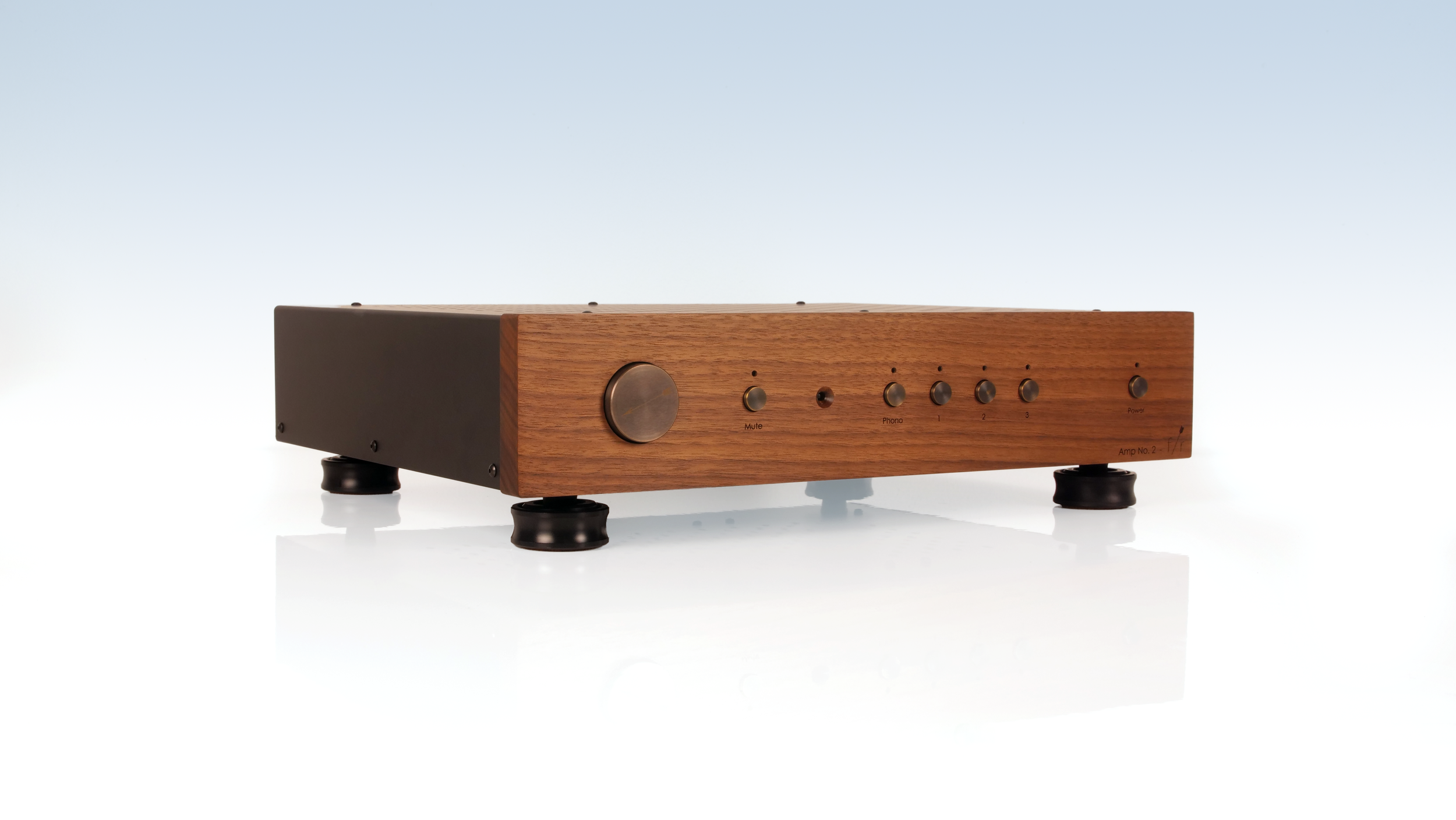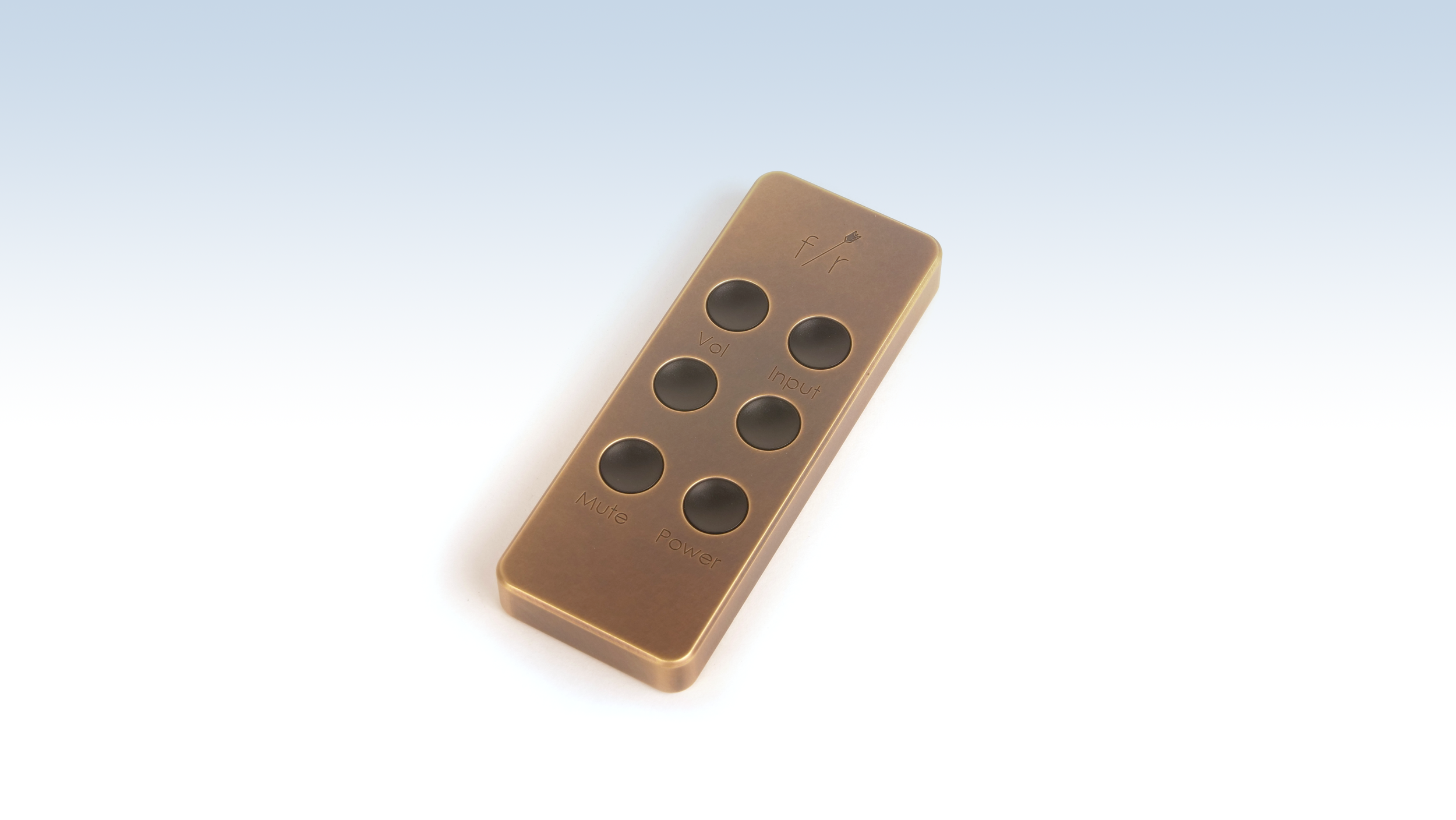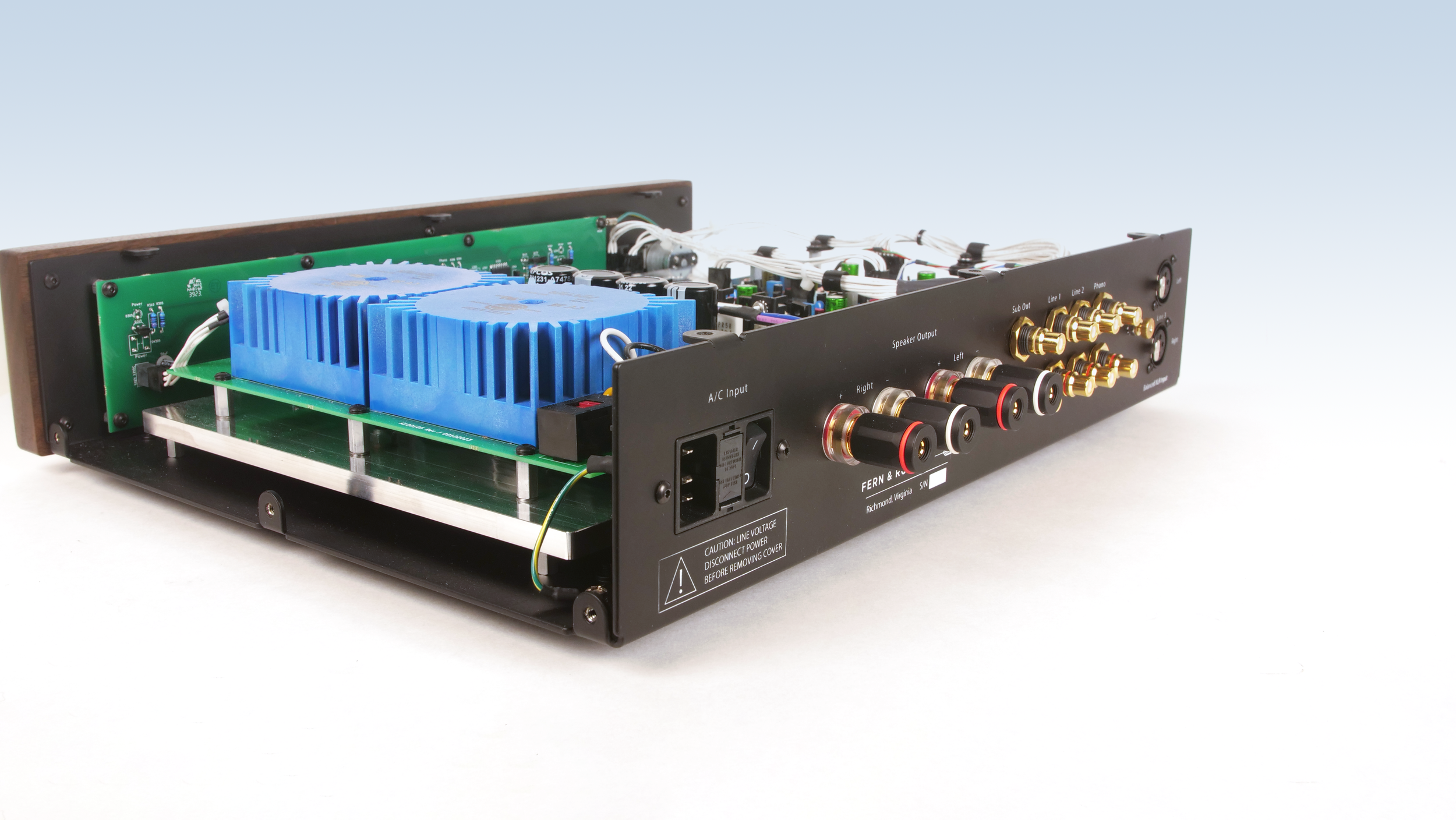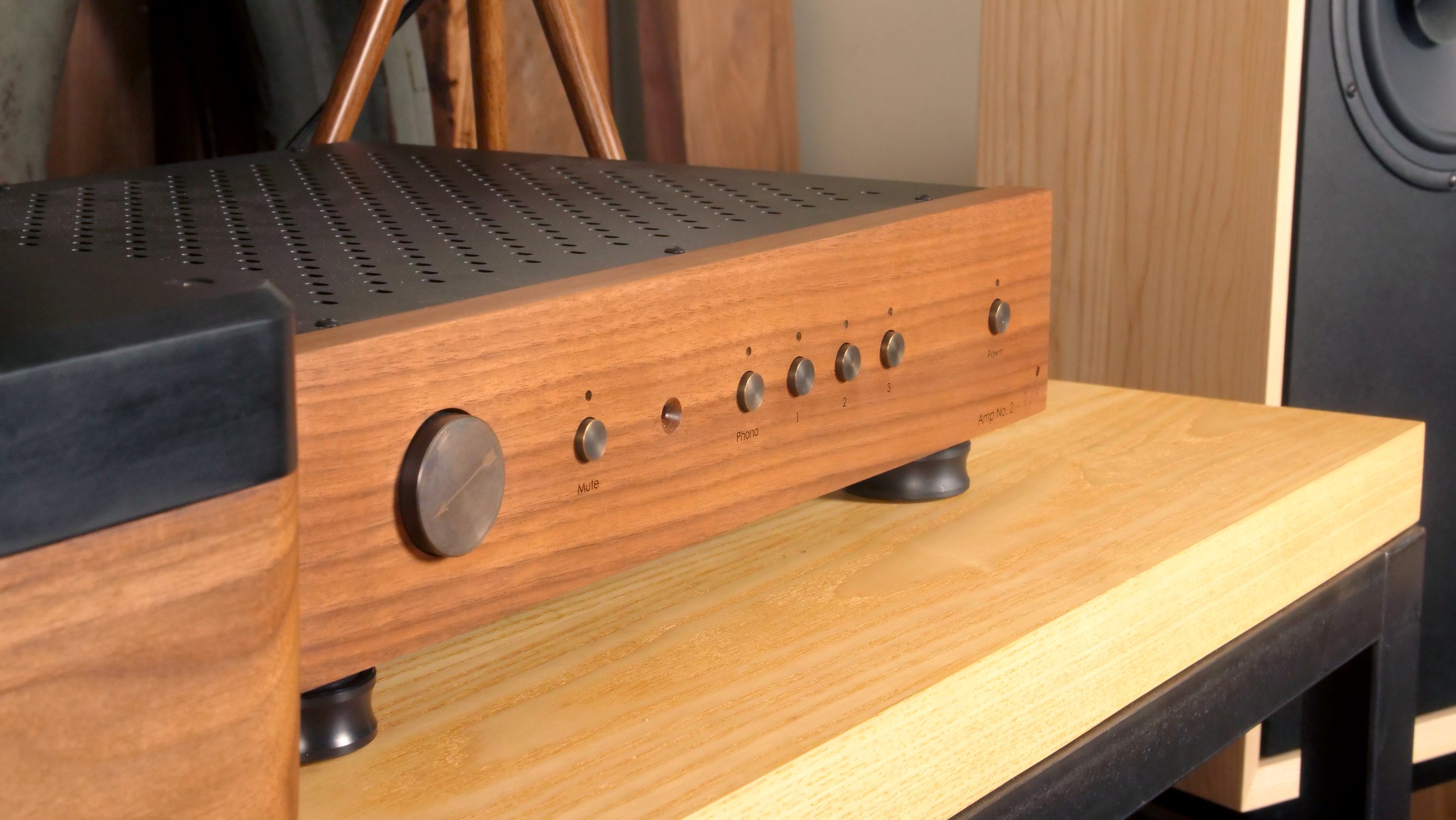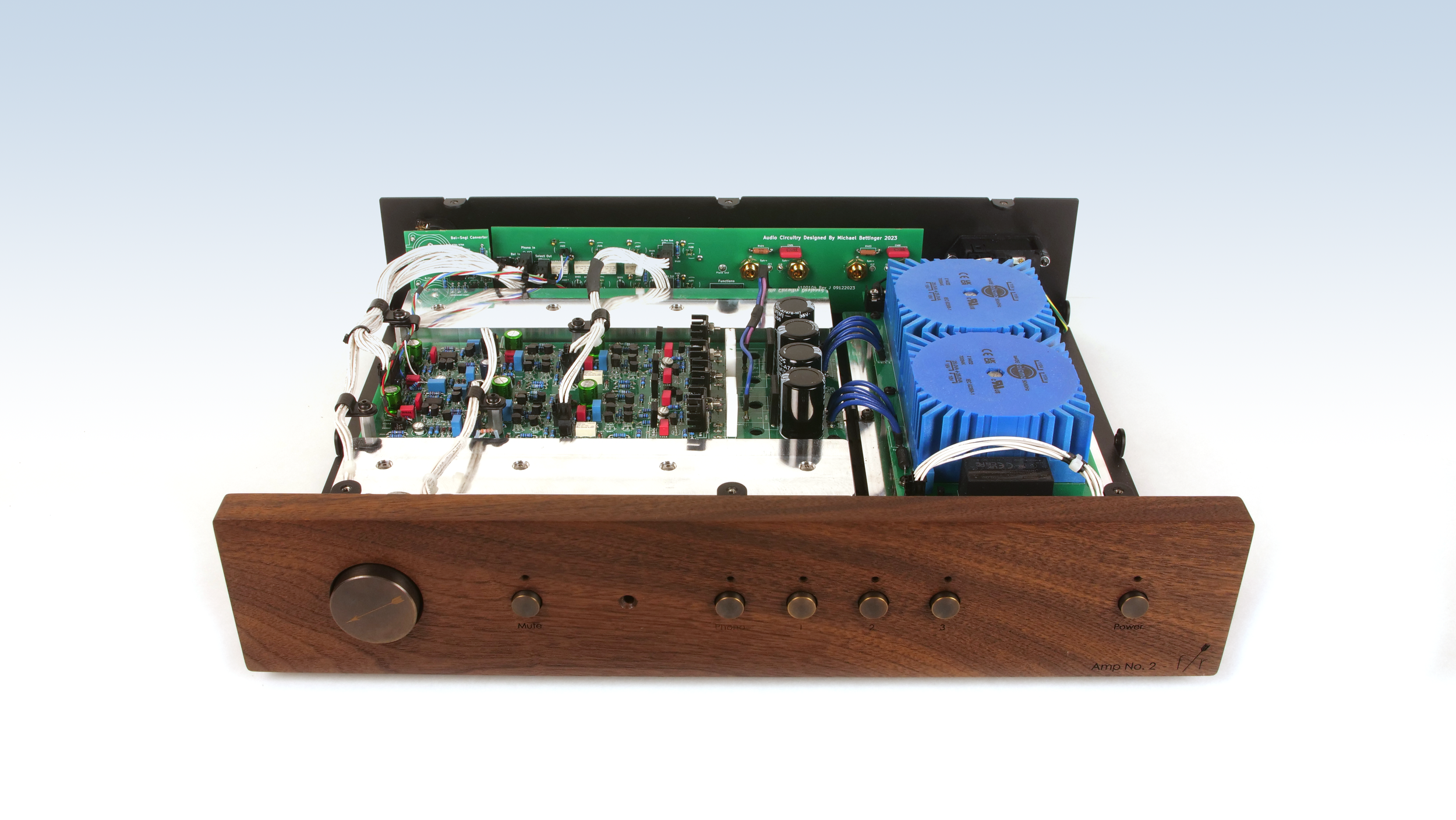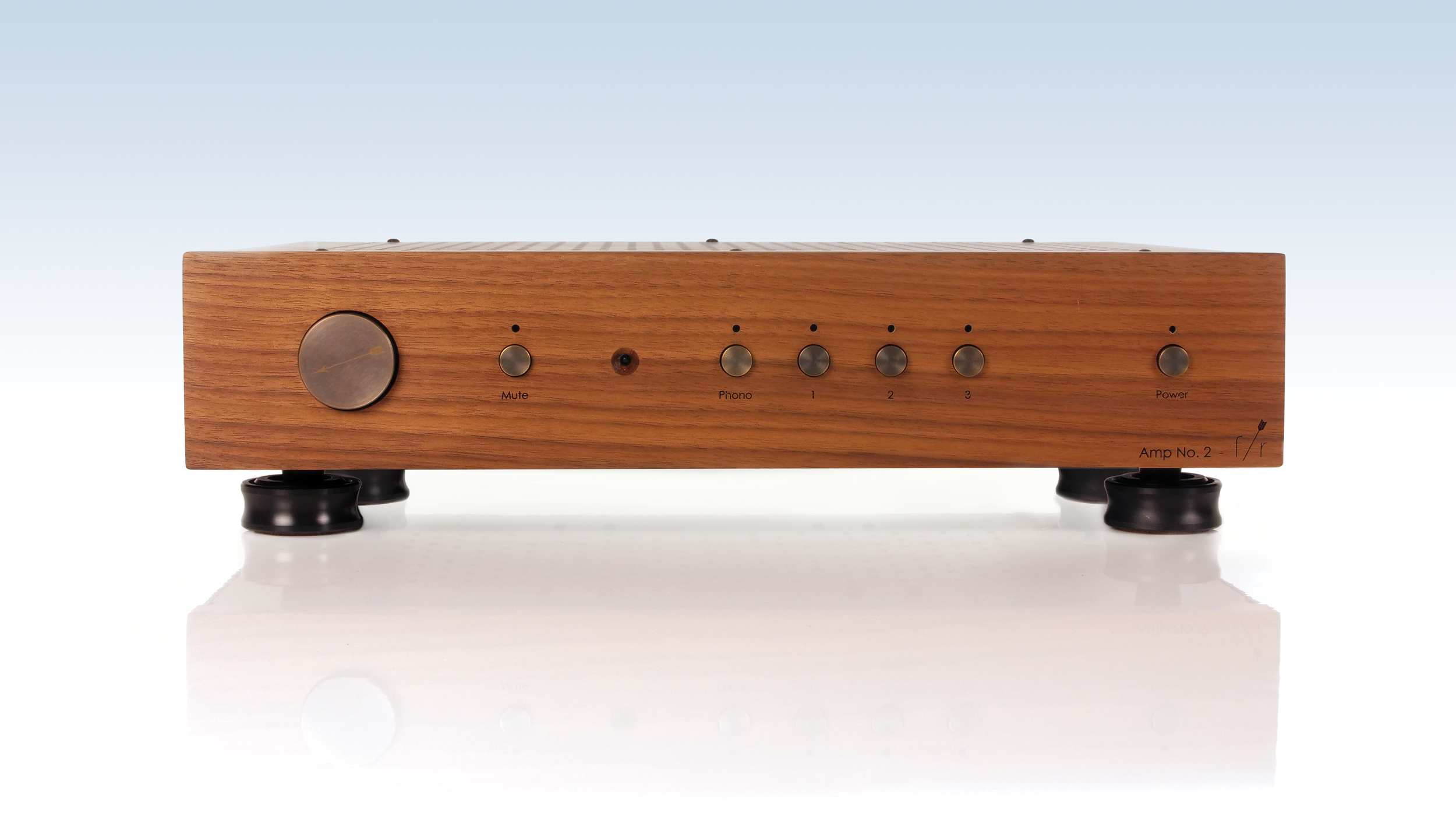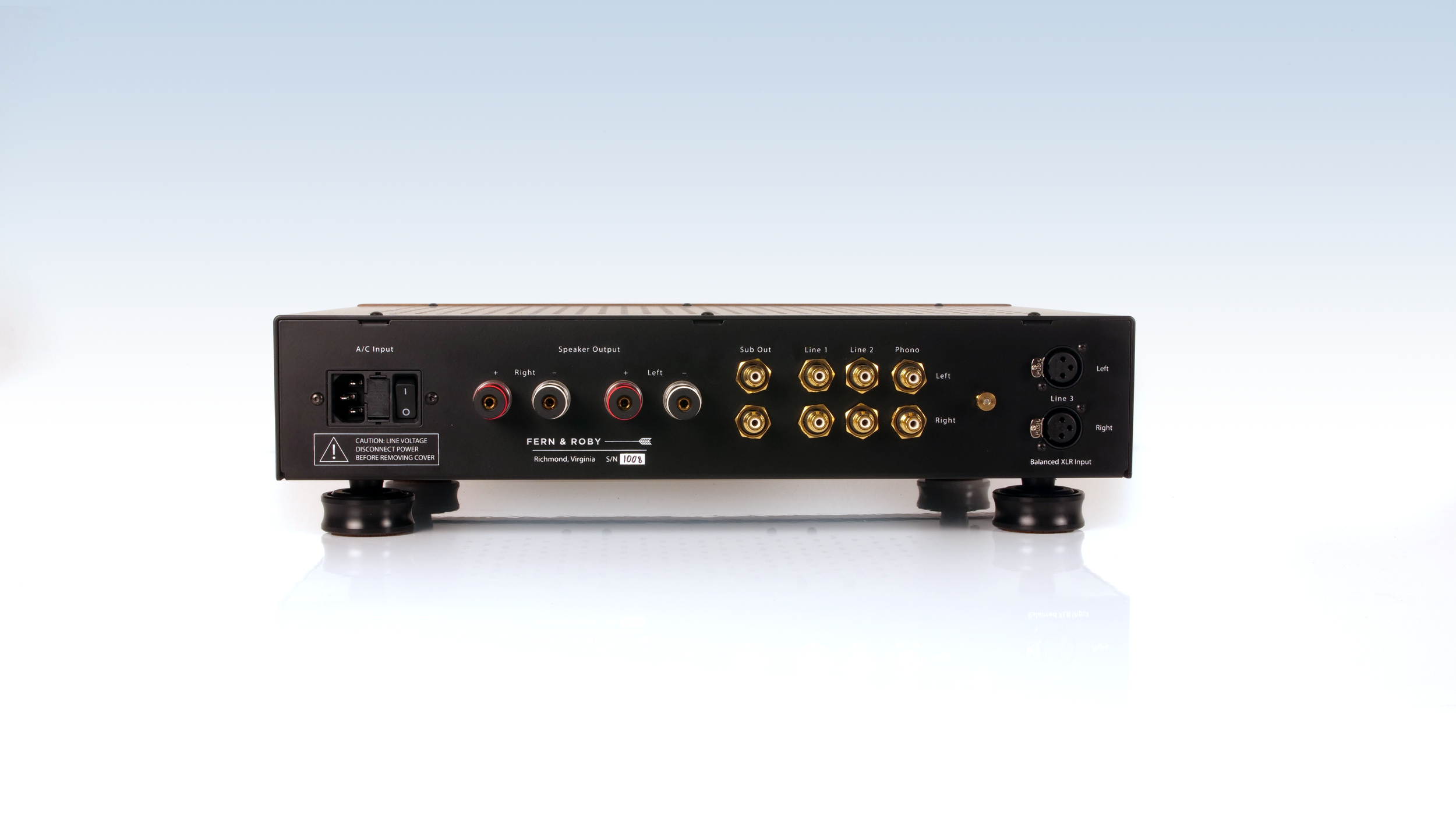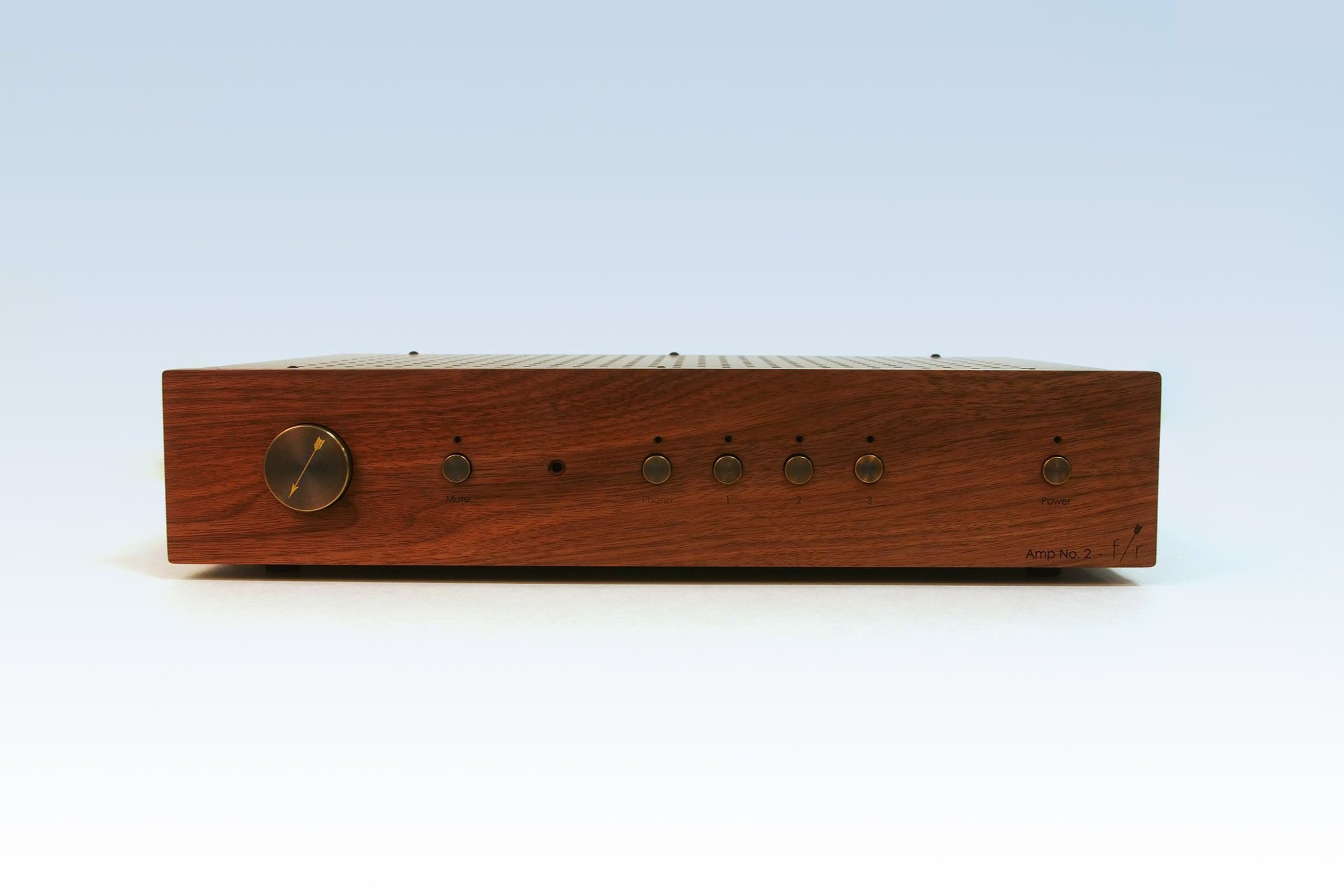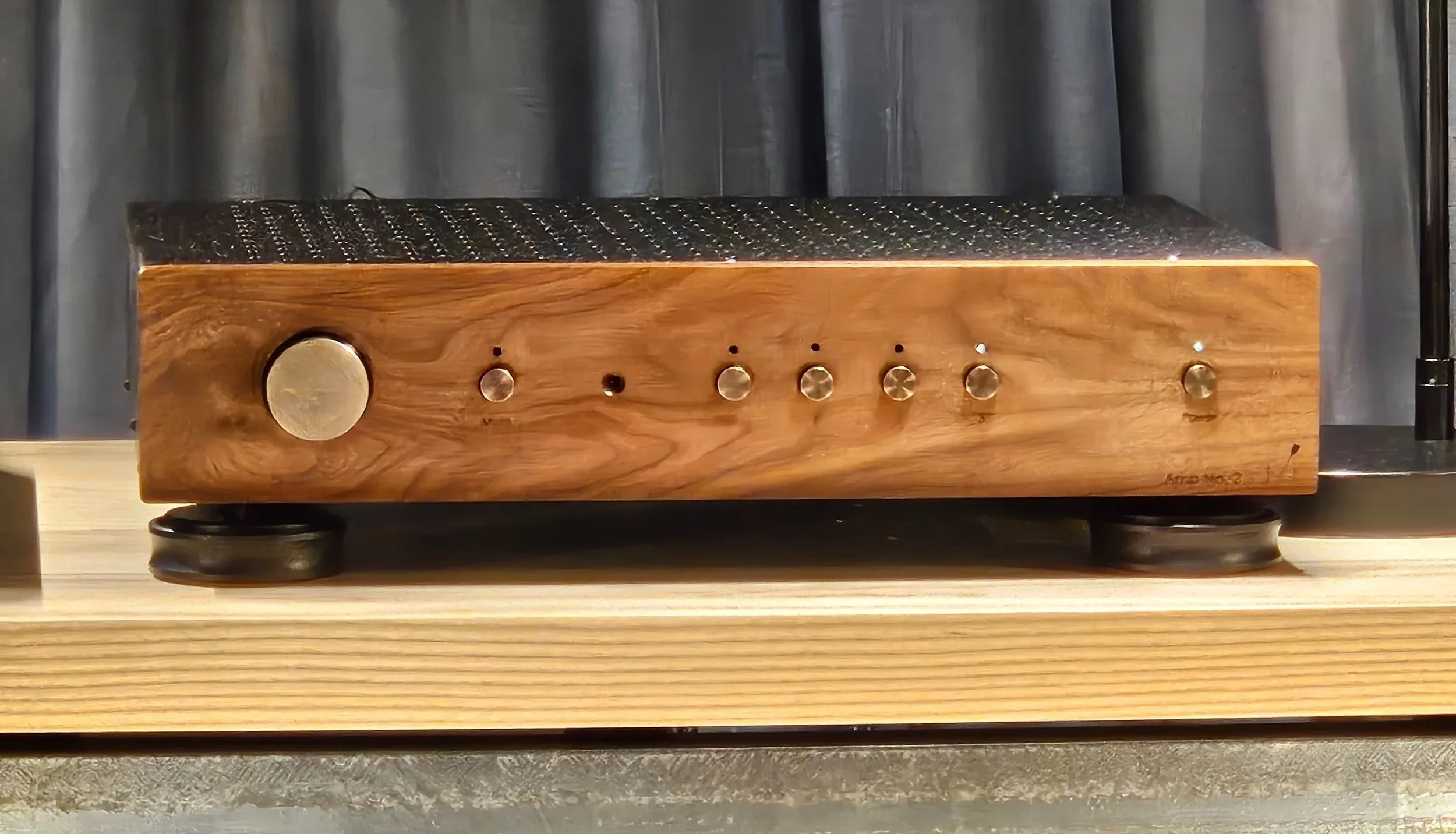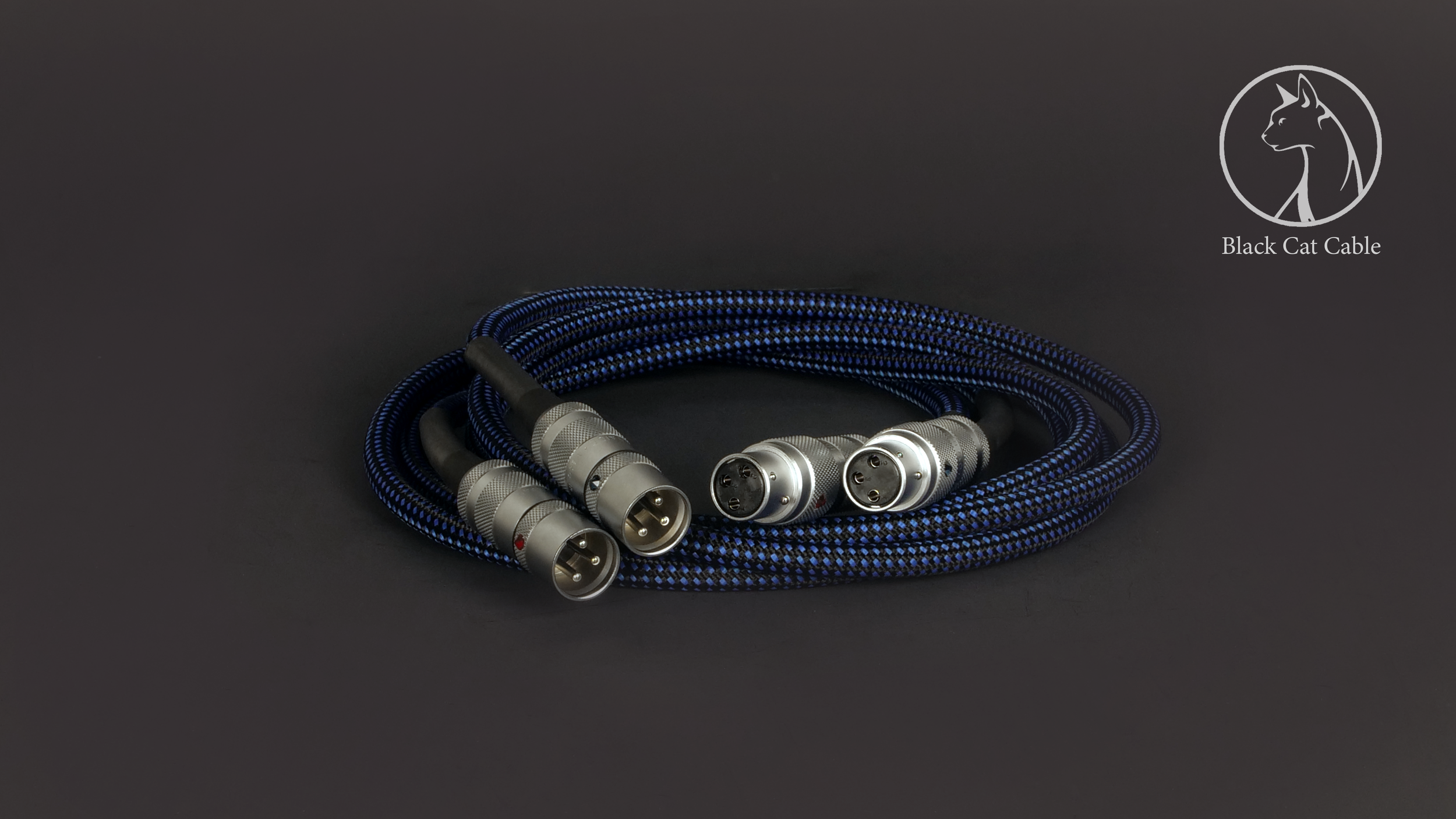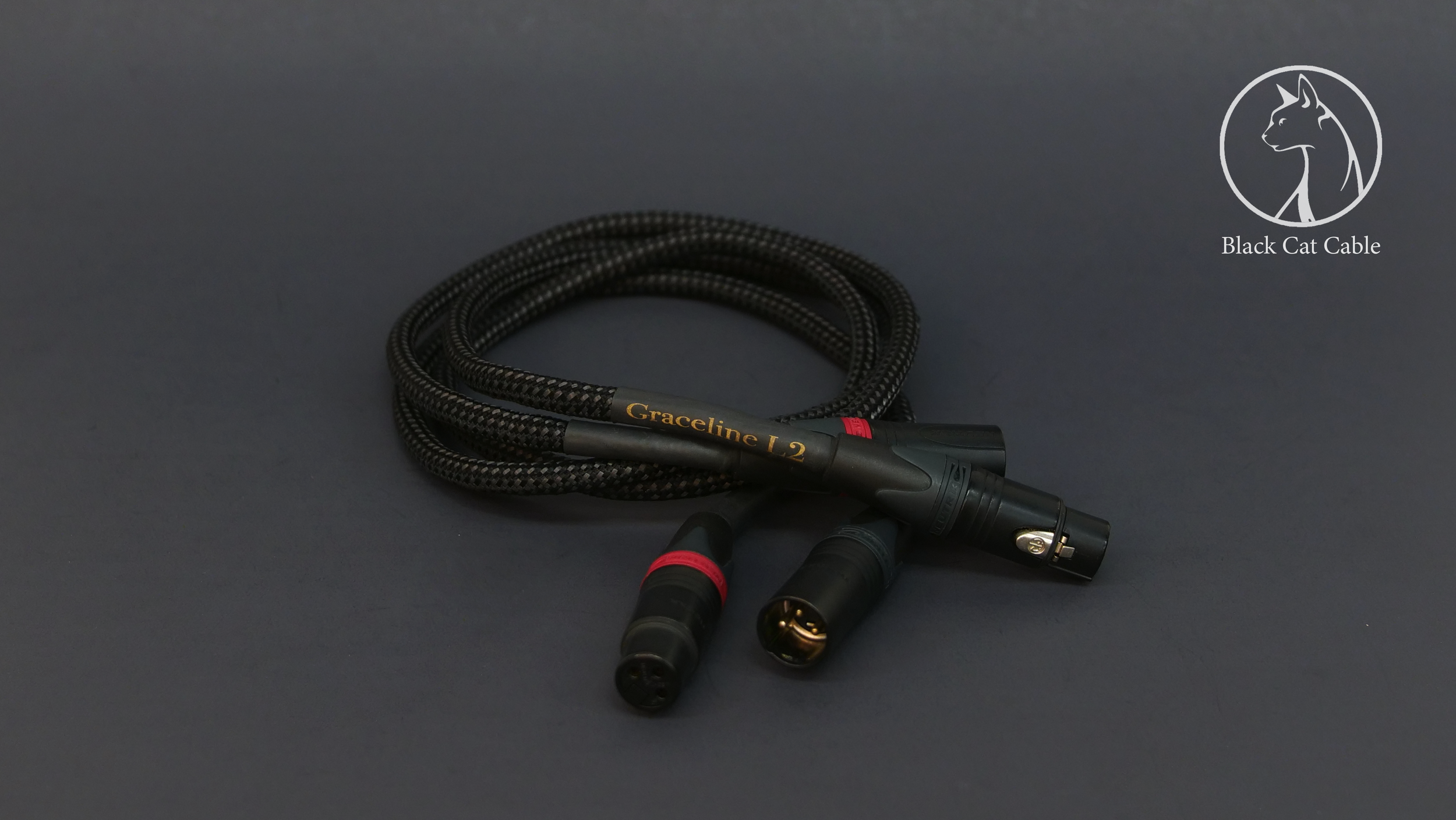Specs & Features
High Current Class A/B design
25 watts per channel
On-Board Phono Pre (MM/MC)
Balanced XLR Input
Two additional Line Inputs (RCA)
Sub Woofer Out (RCA)
High quality RCA connectors and binding posts with copper base metal for the best conductivity.
-
It’s been over a month since I purchased the Fern and Roby Amp No. 2 and I couldn’t be happier. I’ve been a separates (tube pre and tube amp) person for decades, running between 70 to 150 watts per channel. I recently walked to a local audio store and saw the Amp No. 2. Intrigued, I asked to listen to it. Sure, it sounded great in the store but what would it be like in my space? I was able to take the amp home and compare to my current system. Now my significant other isn’t “into” music but when I powered it up and played some acoustic guitar music (Mike Dawes), she turned her head and said, “Wow, what did you do?”. I said, I connected a new amp. We were both stunned at the detail and the warmth that was produced by this amp. It was rare for me to push my previous system much beyond 90db’s so the lower 25 wpc isn’t a factor. While the sound suits me to a tee, the look and simplicity of the design fits so well with the décor of my home. I highly recommend the Fern and Roby Amp No. 2.
-
I have been running my Dynavector 20xl2 into the phono stage of Amp 2. It's better than the Parasound JC3+ I was using when comparing MC-to-MC. It's neck and neck with using my SUT into the MM settings. What an outstanding phono stage--beats a $2700 separate unit. Congrats!!!
-
Read the entire review here.
"The remote, one of the most pleasant in-hand remote experiences I’ve had, is also made from brass with perfectly sized buttons. Perfectly sized because they’re about the size of a fingertip and the remote has a nice amount of heft without being too heavy."
"Adding all of this up, I find the Fern & Roby Amp No. 2 to be a very nice package in terms of design, materials, and build quality that speaks to my love of carefully considered art and craft that in some ways is reminiscent of the Bauhaus aesthetic."
"As much as I love design, a piece of hifi gear, like a building, also has a function that’s as important as its form. And while I have more to say about the Fern & Roby Amp No. 2’s performance, I can tell you that it offers deft control with a touch of sweetness that serves to make music feel vibrant, energized, and fluid."
"This largely acoustic music showcases the Amp No. 2’s agility as we know what these instruments sound like in real life—I have a few guitars, a violin, a Farfisa, and other assorted noise makers around the Barn and I’ve been to my share of concerts—and when paired with the O/96 the sound of this system was very light on its feet, moving in step with Rachel’s every pluck, bow, and tinkle. The sound image was well free from the speakers and provided a clear and precise view onto the musical proceedings, all adding up to a mysterious and luminous experience. Nice."
"During its more than 3 month Barn visit, the Fern & Roby Amp No. 2 got to play a lot of music. Old, new, and a healthy helping of ‘test tracks’ that admittedly added up to more listening time than I needed to write this review. And that was the case for one reason—I simply enjoyed listening to music through it.
If you care about what your hifi gear is made from, how it’s made, where it’s made, who made it, what it looks like, how it feels to live with, and how it sounds, Fern & Roby’s Amp No. 2 offers a very compelling and complete package."
-
Fern & Roby Amp No. 2 integrated amplifier
I stalk a few audio forums because the chatter shows me what different varieties of audiophiles are thinking about, what’s pleasing them, what’s making them angry, and—potentially—what issues reviewers like me are failing to address.
Similarly, I watch a lot of DIY and audio review videos on YouTube. I especially love watching my friend Steve Guttenberg’s Audiophiliac “Viewer System of the Day” videos,1 which provide a global view of the gear choices real people in normal houses have made. I am especially fascinated by how these diverse audiophiles place their components in normal rooms. A few have the heavy stuff sitting on low platforms close to the floor. The majority use audiophile-approved component racks. But more and more often, I’m seeing prized components crowning family-approved bureaus, credenzas, buffets, and sideboards. This pleases me.
In my view, bureau-top music systems are more family/home/group–listening friendly than systems with chrome skyscrapers surveying sprawling amplifier farms covering acres of floor, with power-conversion facilities and 1000W monoblocks roosting on industrial-grade platforms, connected by thick wires perched on cute cable lifters.
So I appreciate components that are bureau friendly. By “bureau friendly,” I mean real-world audio gear designed to look attractive on top of a nice cabinet in a domestic setting. In our Stereophile world, that usually means a sexy-looking integrated amplifier accompanied by a matching DAC-streamer and a smart-looking turntable. Systems like this succeed fully when they make records sound enticing in a “Shush! I want to listen!” way. Danish brand Bang & Olufsen has flourished catering to this aesthetic, and the Europeans have embraced it, but most Ameri-can audiophiles have been reluctant to endorse any system that does not look serious and tech-savvy.
I know from experience that the manner in which a sound system occupies its environment affects every listening session, its feel and its quality. Which is what first attracted my attention to Fern & Roby products: This is serious, quality audio gear that looks elegant and unpretentious. The component I’m about to describe, Fern & Roby’s new, $8500 Amp No. 2 integrated amplifier, is bureau friendly. It looks more stylish than tech-savvy, and it is not big or heavy, but its sound quality would put the sound of many amp farms to shame. A system consisting of an Amp No. 2, a pair of Raven speakers, and a Montrose turntable exemplifies owner-founder Christopher Hildebrand’s materials-based, simple-is-better, form-follows-function design ethic.
Describing the Amp No. 2, F&R’s website says “Our goal for this project was to produce some-thing that will turn your living room into the best listening room possible.”
The Amp No. 2 story
Christopher Hildebrand is the creative force behind Tektonics Design Group and Fern & Roby Audio, which began operations in 2010. He is perhaps best known for his serious but elegant looking turntables made from Richlite and brass, and as the affable, talented industrial and mechanical designer behind Linear Tube Audio’s line of preamplifiers, power amplifiers, and integrated amplifiers.
In an email, Hildebrand wrote that Fern & Roby’s Amp No. 2 is the product of a collaboration between himself and analog audio designer Michael Bettinger, and Luke Smith, another regular F&R collaborator, who helped with the No. 2’s digital controls. It’s Fern & Roby’s second collaboration with Bettinger, who has been designing and building solid state amplifiers for 45 years, starting with GAS Audio in 1981, after fashion-forward engineering savant James Bongiorno’s Great American Sound (G.A.S.) amplifier company went out of business. Since ’81, Bettinger has built a loyal following for the work he has done keeping the mad-cool Ampzilla amplifier and its legendary cohorts alive. More recently, Michael’s company Bettinger Audio Design has developed a range of original designs including F&R’s Amp. No. 2.
Fern & Roby’s integrated Amp No. 2 was launched at the 2023 Capital Audiofest. It is manufactured in Richmond, Virginia, by Tektonics Design Group and described as a “JFET input based 25-watt power amplifier, biased as 5 watts class-A, transitioning to class-AB at higher signal levels.” In an email, Bettinger wrote, “The quality of the circuitry in Amp No. 2 lies in its combination of established circuit topologies and careful selection of high-quality component parts, refined over time for musicality and simplicity.”
The No. 2’s back panel features three line-level inputs: one balanced (XLR) and two single-ended (RCA), plus a phono input (RCA) that’s switchable (inside the chassis) for use with moving magnet or moving coil cartridges. There is also a subwoofer output, on RCA, and of course, two pairs of loudspeaker binding posts of fancy, gold-plated copper.
The No. 2’s asymmetrical front panel is made of solid 3/4"-thick walnut and reads like a primer for Fern & Roby’s relaxed, materials-centered design aesthetic. The amplifier’s name and Fern & Roby’s discrete logo are subtly engraved in the faceplate’s lower-right corner. The faceplate features six buttons in patinated brass and a volume control knob sporting the company’s trademarked arrow symbol. Christopher told me in an email, “The arrow in our logo became our symbol for adventure as we launched Fern & Roby, setting our sights on a distant goal and developing the quality of product necessary to hit the mark.”
Standing alone to the right of the No. 2’s volume knob is a Mute button. To the right of that is the receiver eye for the remote control; the remote provided is a standard Apple remote. (replaced with remote designed and made by F&R) Farther right, a row of four buttons allows input selection: Phono, and the three line-level inputs. The No. 2 comes with a three-year limited warranty.
Readers please note: The Amp No. 2 is made in Richmond, Virginia, in-house, from raw materials. Fern & Roby provides real, local full-time jobs with benefits such as health insurance and paid time off for all employees. Hildebrand says, “These commitments encourage great people to join our firm and make lifelong careers with us.” If that’s how they treat their staff, it’s a good bet they treat their customers with the same respect.
Setup
I auditioned the Fern & Roby Amp No. 2 with my best digital sources—the dCS Lina DAC and Master Clock, Denafrips Terminator Plus DAC—and a Dr. Feickert Analogue Blackbird turntable feeding MoFi’s MasterPhono phono stage. All connections, including tonearm and speakers, were made with Cardas Clear Beyond cabling. For an alternative perspective, I used a full loom of Triode Wire Lab Spirit II interconnects and American speaker cables. Auditioning the Fern & Roby with two brands of wire helped me separate out the cable sound from the amplifier’s sound.
When the time came to audition the No. 2’s phono stage, I started with the EMT JSD 6 moving coil cartridge, which I reviewed in Gramophone Dreams #785—so I removed the No. 2’s cover and flipped two relatively large toggle switches (one for each channel) from the MM to the MC position. The insides of the No. 2 looked more expensive and luxurious than its modestly conceived exterior. Its quality parts, smart layout, and bright, machined heatsinks were treats for the eye.
Listening with LS3/5a
I can’t imagine anyone not enjoying “Bonaparte’s Retreat” (AFS 1568), performed by W. H. Stepp on a Library of Congress anthology entitled American Fiddle Tunes (Rounder CD 18964 1518-2). I am betting this famous American fiddle tune will march and dance you to a higher form of consciousness, just as it was intended to do. I’ve heard this infectious song a hundred times, performed by a score of different artists, but this high-speed W. H. Stepp version is borderline transcendent. Wikipedia says “Stepp’s version of this song was used as a major component of Aaron Copland’s orchestral composition ‘Hoe-Down’ from the ballet Rodeo. Copland most likely learned it from the transcription found in the Lomaxes’ book Our Singing Country.”
“Bonaparte’s Retreat” was recorded by Alan Lomax and his new bride Elizabeth in 1937, according to the 72-page fact- and photo-filled booklet that came with the CD. The track’s extreme high sound quality suggests that it was recorded electrically, direct-to-disc (one microphone, one cable, and a Presto instantaneous disc recorder).6 More traditional renditions of “Bonaparte’s Retreat” move slower, like Irish airs, and celebrate how happy residents of the British Isles were when Napoleon was repelled from Russia in 1815. Stepp’s 1937 version modernizes and Americanizes the tune, revving its speed up for Paganini-level thrills bathed in Irish-poet soulfulness and pure Stradivarius tone. Yep, Maestro Stepp played a real Stradivarius. He talks about it on this recording.
Impressively, “Bonaparte’s Retreat” showed me upfront what Fern & Roby’s Amp No. 2 was capable of, at least as far as powering my 15 ohm Falcons. While playing Stepp’s Bonaparte, it showcased its talent for spirited rhythm keeping and tone truthfulness. Instrumental and vocal textures were marginally less pronounced and less contrasty than I experience with Elekit’s TU-8900 or the Parasound Halo A 21+ amplifier driving the same speakers. But this does not mean the No. 2 plays dull or blurred; it does not. Its demeanor is crisp, naturally focused, and super athletic, with excel-lent flow and boogie. It doesn’t sound solid state. Or soft. Or tubey. Or anything but exciting.
I’ve noticed that, when I’m listening to recordings and the sound is extra-lucid, super-transparent, and demonstration-quality amazing, my left brain gets stuck oohing and awing at what its engineers have wrought. Eventually, with repeated listening to the same album, my right brain steps in (or my left brain gets out of the way) and the musician’s work comes forward.
No repeated listening was required when I listened to Todd Garfinkle’s production of Sorrow of the River (M•A Recordings 074A) featuring Guo Yazhi playing his suona in a small percussion and wind ensemble performing 12 traditional Chinese folk songs. As I listened, I kept shaking my head in awe of the purity, staggering dimensionality, and unaffected beauty of the recorded sound. But this recording’s fantastic sound immediately helped me focus on the work of individual musicians, allowing me to notice how readily their playing inspired reveries propelled by a strong sense of motion: rivers flowing, birds swooping, sirens singing, minstrels marching—movements suggested by the onomatopoetics of Sorrow’s sweeping melodies.
I used this recording to see how the 25W Amp No. 2 (and my Onkyo CD player) would handle plucked strings and the suona’s delicate, flutelike tones floating over thunderous earth-shaking drums. This was Amp No. 2’s most dramatic success. The Fern & Roby made this fantastic recording sound wild and primordial, but it also made it sound bright and pristinely focused, with each instrument distinctly outlined and nailed to an exact spot on the soundstage floor. Spellbinding.
What I enjoyed most in using the Fern & Roby No. 2 was how it succinctly conveyed contrasting elements: loud and quiet, far and near, present and absent, foggy and clear.
The Amp No. 2’s phono input
When I inquired about MC loading options, Chris Hildebrand told me the No. 2 loads moving coils at one value only: 500 ohms. My main reference cartridge, EMT’s JSD 6 moving coil, sports a relatively high 24 ohm internal impedance and the manufacturer recommends a load of 100–200 ohms. During my JSD 6 auditions in GD78, I experimented with 100 ohms and 500 ohms via MoFi’s new Master Phono and PrimaLuna’s all-tube EVO 100 phono stage. With both preamps, I found that 100 ohms gave my preferred balance between vigor and relaxed breathing, but 500 ohms seemed okay as a second choice.
Using the Amp No. 2 with the EMT moving coil, the sound was bright lighting-wise, exceedingly clear and resolved, but more up-front than with the MoFi MasterPhono at 100 ohms. Playing a first pressing of Slim Harpo Sings Raining in my Heart (Excello LP 8003), I heard a bunch of tiny low-signal sounds that I never noticed before. However, I’ve played this 1961 mono record with countless cartridges and phono stages and they all made it sound rich of tone and dramatically textured, with a whisky-colored dose of early ’60s tube glow and Fairchild-compressor presence; the No. 2 with the JSD 6 reduced those effects to something more hi-fi sounding. The JSD 6 into the No. 2’s MC input made this vintage recording sound like a modern, drier, hyperdetailed reissue. Bass was clean, perky, and tight, but not as relaxed or heavy loping as it should be.
Fortunately, Harpo’s iconic nasal “I’m a King Bee” voice and incredible “Raining in My Heart” harmonica came completely back with Denon’s DL-103 moving coil mounted on my 1969 Lenco. With that deck and cartridge, Slim’s vibe came alive. His harmonica crackled with full tactility and lit up the air like streak lightning.
Fern & Roby’s MC phono suppressed none of the Denon’s musicality. What came out of my Falcons reminded me a lot of what came out of jukeboxes ca. 1961: the sound was punchy, crunchy, chunky, and slow-danceable. The No. 2 pulled good blues romance from the DL-103. 2M Black moving magnet cartridge (standard, not LVB version) sounded satisfyingly rich, relaxed, and refined. Soundspace depth was excellent. But compared to the Denon moving coil and the EMT, macrodynamics felt less macro. The Black made Harpo’s deep-throated voice and signature nasality sound restrained and Slim’s harmonica harmonics feel too tidy.
With the DeVore Fidelity O/93
Hoping to make a system that could show Fern & Roby’s Amp No. 2 in a way it might be used, I connected my 10 ohm, 93dB sensitive DeVore Fidelity O/93 floor-standing speakers. F&R’s 8 ohm Raven III speakers are specified at 94dB sensitivity, measure approximately 33" × 12" × 12", weigh 55lb each, and cost $8500/pair. The DeVore O/93’s measure 35" × 15" × 10", weigh 46lb, and cost $8400/pair. Both are ported boxes with 10" paper-cone drivers from Seas and wide front baffles.
I celebrated the DeVore–F&R marriage by listening to Todd Garfinkle’s latest release Será Una Noche Otra Noche in a 24/176 WAV file via DCS’s Lina DAC and Master Clock. Otra Noche (M092A) is a continuation of M•A Recordings’ project “Sera Una Noche,” which began in 1998, then continued with La Segunda in 2003.7 Now, 20 years later, Otra Noche appears. It is the most vividly descriptive digital recording I’ve ever encountered. It comes across like 70mm film, in Technicolor. No recording I know delivers dimensionality more voluminous or explicitly portrayed.
This Otra Noche WAV file has raised my opinion of what digital recording is capable of, how flat-out amazing the dCS Lina DAC can sound, and what talented musicians and master recordist-producer Todd Garfinkle can accomplish with two microphones in a small stone church.
Otra Noche’s demonstration-quality sound elicited a scintillating star turn from the DeVore Fidelity O/93’s, which have never sounded faster, more resolving, more transparent, or more revved-up alive than when powered by the F&R integrated.
This was Fern & Roby’s top “wow!” moment, wherein the Amp No. 2 flaunted its dynamic charge, rhythm-keeping prowess, and invisibility. The No. 2’s front panel seems so Pledge wax–ready—you really could put it on your grandma’s bureau—that I was surprised how much dirt-kicking, bucking-bull energy it could pump into the DeVore O/93’s.
With the GoldenEar BRX
Having heard the results when the Amp No. 2 put clean voltage into the 15 ohm Falcons and the 10 ohm DeVores, I was curious to see if it could sink enough quick current into a load that’s less than 4 ohms.
Every time I play GoldenEar’s BRX speakers, I’m reminded how much I love their molded plastic cabinets, bent-metal grilles, folded-ribbon tweeters, and their balanced, transparent sound. The BRXs impress me with the depth of their tuneful bass, extraordinary transparency, and (with the right amp) lively, super clean dynamics.
And guess what? Powered by F&R’s Amp No. 2, the BRX sang like the Queen of Gospel and danced like the King of Pop. Powering the GoldenEars, the F&R produced exquisite tone, tantalizing detail, electrically charged transients, and quick, clean bass, with no evidence of clipping or distortion.
The F&R Amp No. 2 and the GoldenEar BRX speakers flattered each other. I love it when that happens.
Compared to Pass Labs INT-25
Despite very different cosmetics, the 25W, $7250 Pass Labs class-A INT-25 integrated amplifier, which I reviewed in January 2020, seemed like a proper comparison for the 25W, $8500 Fern & Roby Amp No. 2.
As I have stated many times, the Nelson Pass–designed INT-25 is the most transparent and flat-out dynamic solid-state amplifier I’ve encountered. That remains true. Fern & Roby’s Amp No. 2 was a bit less transparent and a bit less supercharged, but its talent for singing, dancing, and making beautiful sound resulted in sensual pleasures I’ve never gotten with the INT-25. The No. 2 presents music with a vital, spirited charm that I found pleasantly addictive and deeply satisfying.
Conclusion
One night, as I was listening to my system with the Amp No. 2, I found myself thinking, Omg! This amp is really lighting up those DeVores! I wondered how F&R managed to get this much vivid, high-energy excitement out of an amp that looks laid-back and tasteful. Then I remembered that the Amp No. 2’s designer, Michael Bettinger, and his company G.A.S. have carried on a 40-year relationship with the designs of one of my amp-design heroes, James Bongiorno, chief designer at SAE, G.A.S., and Sumo.
As I remember it, Bongiorno’s wild-style Ampzilla was the opposite of tasteful and domestic. It had an industrial look and a type-A personality, and it was the first solid state amp I felt I could marry and settle down with. During these auditions, Fern & Roby’s Amp No. 2 performed like a silk-suited version of that renowned monster. And that is extremely high praise.
Michael Bettinger and Christopher Hildebrand have accomplished exactly what they set out to do: produced something that could turn people’s living rooms “into the best listening room possible.”
ASSOCIATED EQUIPMENT
Analog sources Dr. Feickert Analogue Blackbird turntable with EMT 912-HI tonearm and EMT JSD 6 moving coil cartridge, Sorane SA-1.2 Tonearm with a Dynavector XX2 moving coil and Ortofon’s 2M Black moving magnet; Lenco L75 turntable with Denon DL-103 moving coil; MoFi MasterPhono and Prima Luna EVO 100 phono stages; Sutherland Engineering SUTZ transimpedance MC headamp and Hagerman Zero transimpedance MC headamp.
Digital sources Denafrips Terminator Plus, HoloAudio Spring 3, dCS Lina (with Master Clock) DACs; Onkyo C-7030 CD player. Preamplifier HoloAudio Serene.
Power amplifiers Parasound Halo A 21+, Elekit TU-8900. Integrated amplifier Pass Labs INT-25.
Loudspeakers Falcon Acoustics LS3/5a Gold Badge, DeVore Fidelity O/93, GoldenEar BRX.
Cables Digital: AudioQuest Diamond USB (with Denafrips and HoloAudio DACs). Tonearm: Cardas Clear Beyond, Grado Labs. Interconnect: Cardas Clear Beyond, Triode Wire Spirit II. Speaker: Cardas Clear Beyond, Triode Wire American Series. AC: AudioQuest Tornado.
Accessories AudioQuest Niagara 1000 power conditioner; Harmonic Resolution Systems M3X-1719-AMG isolation platform (for Parasound Halo A 21+), Musical Surroundings Fozgometer V2, Riverstone Audio VTF gauge, Sound Anchor Reference speaker stands.—Herb Reichert
-
"It’s as if someone made me an integrated amplifier to my custom specifications.
…
In high-end audio, however, looks only take you so far. The Fern and Roby Amp No. 2 has a beauty that extends far beyond the surface.
…
The Fern and Roby Amp No. 2 played the role of the scrappy upstart, the kid looking to make a name, with unexpected confidence. The No. 2 was adept at capturing all those new facets to [Steely Dan's Aja], the relegation of the digital glare I’ve always found troubling since Aja has always been considered a benchmark in audiophile circles.
…
[Amp No. 2] places a priority on excellent sound"
We offer a 14-day audition period for limited products made by Fern & Roby during which you can return your Fern & Roby speakers or amplifier for any reason.
This program is subject to the following conditions:
Payment in full for the products covered by this program.
Our payment processor does not refund processing fees, therefore all returns will incorporate a 3.5% fee for the original transaction and also for the refund deducted from the refund.
14-day time period for the home trial begins upon receipt of product.
Return can be for any reason, but you must call or email within the given time period for return authorization.
Equipment must be returned in as-new condition, or you may be liable for repair costs or re-stocking fees.
Returns must be shipped within one week of receiving the return authorization.
Customers (US & International) are responsible for all shipping charges, outbound and return.
International returns must be shipped to us with all shipping and customs brokerage fees prepaid.
Shipping charges, customs fees, and customs brokerage fees will not be refunded or reimbursed.
Original purchase funds will be processed within five business days of the receipt of the unit.
Sales that involve a trade-in are final and cannot be combined with other discounts.
Sales that involve a package discount with other products are final.
Sales of b-stock, demo, or trade-in units are final.
More information on our shipping and return policies as well as our warranty can be found on our FAQs page here.

